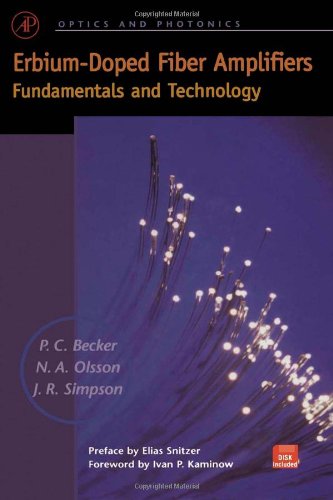Philippe C. Becker, N. Anders Olsson, Jay R. Simpson9780120845903, 0-12-084590-3
Table of contents :
CONTENTS……Page 6
Foreword……Page 11
Preface……Page 14
Acknowledgements……Page 16
1.1 Long Haul Fiber Networks……Page 18
1.2 Historical Development of Erbium-Doped Fiber Amplifiers……Page 22
A.2.3 Starting OASIX®……Page 0
2.1 Introduction……Page 30
2.2 Conventional Communication Fiber……Page 31
2.3.1 Rare Earth Vapor Phase Delivery Methods……Page 33
2.3.2 Rare Earth Solution-Doping Methods……Page 38
2.3.3 Rod and Tube Methods……Page 40
2.4.1 Evanescent Field……Page 42
2.4.2 Double Clad Fiber Design……Page 43
2.5 Compositions……Page 44
2.6.1 Fiber Refractive Index and Composition Profile……Page 46
2.6.3 Alternate Glass Host Fabrication……Page 47
3.2 Fiber Connectors……Page 60
3.3 Fusion Splicing……Page 65
3.4 Pump and Signal Combiners……Page 67
3.5 Isolators……Page 69
3.6 Circulators……Page 70
3.8.1 Introduction……Page 72
3.8.2 Applications of Bragg Gratings……Page 74
3.8.3 Long Period Gratings……Page 76
3.9 Signal Multiplexers and Demultiplexers……Page 78
3.10 Signal Add/Drop Components……Page 79
3.11 Dispersion Compensation Components……Page 80
3.13 Pump Lasers……Page 83
4.2 Atomic Physics of the Rare Earths……Page 104
4.2.3 Semiempirical Atomic and Crystal Field Hamiltonians……Page 109
4.2.4 Energy Level Fitting……Page 111
4.3 Optical Spectra of Rare Earth Ions……Page 112
4.4.1 Transition Cross Sections……Page 116
4.4.2 Lifetimes……Page 122
4.4.3 Linewidths and Broadening……Page 125
4.5 Spectroscopy of the Er[sup(3+)] Ion……Page 127
4.5.1 Lifetimes……Page 128
4.5.2 Er[sup(3+)] Spectra, Cross Sections, and Linewidths……Page 131
4.6 Er[sup(3+)] -Er[sup(3+)] Interaction Effects……Page 137
5.2.1 Three-Level Rate Equations……Page 148
5.2.2 The Overlap Factor……Page 157
5.3.1 Validity of the Two-Level Approach……Page 161
5.3.2 Generalized Rate Equations……Page 163
5.4 Amplified Spontaneous Emission……Page 164
5.5 Analytical Solutions to the Two-Level System……Page 166
6.2 Absorption and Emission Cross Sections……Page 170
6.3 Gain and ASE Modeling……Page 173
6.3.2 Average Inversion Relationship……Page 175
6.3.3 Inhomogeneous Broadening……Page 176
6.4.1 Signal Gain, ASE Generation, and Population Inversion……Page 178
6.4.3 Spectral Profile of the ASE……Page 186
6.4.4 Small Signal Spectral Gain and Noise Modeling……Page 188
6.4.6 Power Amplifier Modeling……Page 192
6.4.7 Effective Parameter Modeling……Page 195
6.6.1 Model Equations……Page 203
6.6.3 800 nm Band Pumping……Page 205
6.7 Er[sup(3+)] -Er[sup(3+)] Interaction Effects……Page 208
6.7.1 Upconversion Effects on Amplifier Performance……Page 210
6.7.2 Pair Induced Quenching……Page 212
7.1 Introduction……Page 218
7.2.1 Classical Derivation of Optical Amplifier Noise……Page 219
7.2.2 Noise at the Output of an Optical Amplifier……Page 222
7.2.3 Comparison of Optical Amplifier Devices……Page 227
7.3 Optical Noise: System Aspects……Page 229
7.3.1 Receivers……Page 230
7.3.2 Bit Error Rate Calculations – Direct Detection……Page 231
7.3.4 Optical Inline Amplifiers – Amplifier Chains……Page 243
7.3.5 Noise in Optical Power Amplifiers……Page 252
7.3.6 Nonlinearity Issues……Page 253
7.3.7 Analog Applications……Page 257
8.2.1 Gain Measurements……Page 268
8.2.2 Power Conversion Efficiency……Page 274
8.2.3 Noise Figure Measurements……Page 275
8.3 Amplifier Design Issues……Page 280
8.3.1 Copropagating and Counterpropagating Pumping Issues……Page 282
8.3.2 Choice of Fiber Lengths and Geometries for Various Applications……Page 285
8.3.3 Multistage Amplifiers……Page 290
8.3.4 Bidirectional Amplifiers……Page 294
8.3.5 Power Amplifiers……Page 297
8.3.6 WDM Amplifier Design Issues……Page 301
8.3.7 Distributed Amplifiers……Page 312
8.3.8 Waveguide Amplifiers……Page 319
9.1 Introduction……Page 338
9.2.1 Preamplifiers……Page 340
9.2.2 Inline Amplifiers – Single Channel Transmission……Page 344
9.2.3 Mine Amplifiers – WDM Transmission……Page 352
9.2.4 Repeaterless Systems……Page 362
9.2.5 Remote Pumping……Page 363
9.2.6 Analog Applications……Page 368
9.2.7 Gain Peaking and Self-Filtering……Page 371
9.2.8 Polarization Issues……Page 376
9.2.9 Transient Effects……Page 380
9.3.1 Principles……Page 384
9.3.2 System Results and Milestones……Page 391
10.1.1 Gain in a Four-Level System……Page 418
10.2.1 Introduction……Page 421
10.2.2 Spectroscopic Properties……Page 422
10.2.3 Gain Results for Pr[sup(3+)] -doped Fiber Amplifiers……Page 423
10.2.4 Modeling of the Pr[sup(3+)] -doped Fiber Amplifier Gain……Page 429
10.2.5 System Results……Page 433
10.3.1 Introduction……Page 435
10.3.2 Gain Results for Nd[sup(3+)] -Doped Fiber Amplifiers……Page 436
10.3.3 Modeling of the Nd[sup(3+)] -Doped Fiber Amplifier Gain……Page 437
A.2.1 System Requirements……Page 446
A.3.1 Fibers and Modeling Parameters……Page 447
A.3.3 Device Types Simulated……Page 448
A.3.5 Screens and Menus……Page 449
A.3.6 Simulation Looping and Output Modes……Page 450
A.4.1 Main/Entry Screen……Page 451
A.4.3 Additional Signals Screen……Page 452
A.4.4 Output Setup Screen……Page 453
A.4.5 Simulation Status Box……Page 454
A.5.2 Choosing Loop Order……Page 455
A.5.4 Multiple Parameters Varied in a Loop……Page 456
A.5.6 Output Modes……Page 457
A.6.1 Single-Run, Single-Stage EDFA……Page 459
A.7 Computation of Signal Related Quantities……Page 460
A.8 Computation of ASE Related Quantities……Page 461
A.9 Basic Operating Principles……Page 462
A.9.1 Simulation Speed and the Number of Waves……Page 463
A.9.2 Causes and Remedies for Convergence Failure……Page 464
A.10 Comment on the treatment of losses……Page 465
A……Page 468
B……Page 469
E……Page 470
G……Page 471
K……Page 472
O……Page 473
P……Page 474
S……Page 475
W……Page 476
Z……Page 477







Reviews
There are no reviews yet.